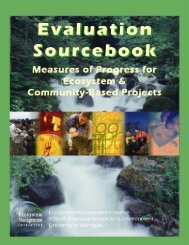A Guide to Strategic Planning for Rural Communities - USDA Rural ...
A Guide to Strategic Planning for Rural Communities - USDA Rural ...
A Guide to Strategic Planning for Rural Communities - USDA Rural ...
You also want an ePaper? Increase the reach of your titles
YUMPU automatically turns print PDFs into web optimized ePapers that Google loves.
Phase 2: Implementing the Plan<br />
No strategic plan is complete just because it gets written. The hard work of implementation<br />
comes next. Everything cannot be done at once, so a strategic plan should be divided in<strong>to</strong> several<br />
programs of work. Divide a 10-year plan in<strong>to</strong> five 2-year work programs. Each two-year work<br />
program describes who will do things, <strong>to</strong> or with whom, what will be done, at what cost, and how<br />
success will be measured.<br />
Select goals and strategies from the strategic plan that you will begin during the first 2-year<br />
period. The work program must contain realistic estimates of expenses and income, describe<br />
tasks that need <strong>to</strong> be done, identify who will do the tasks, and set a timeframe <strong>for</strong> completion.<br />
Although this in<strong>for</strong>mation may change under unexpected circumstances, your work program<br />
should be as detailed and realistic as possible. Next, decide how <strong>to</strong> measure your progress and<br />
select “benchmark targets” <strong>for</strong> the first 2 years. These targets help evaluate your progress and<br />
report on outputs.<br />
Implementation may be the most difficult but most important phase in the community<br />
development process. It is in this phase that the planned-<strong>for</strong> resources can be lost, partnerships<br />
become either close or distant, projects are started and then managed, and results become visible.<br />
Experience shows that successful communities usually do these things:<br />
• Start with a smaller project that has a high chance of success,<br />
• Manage their resources wisely and get the most value <strong>for</strong> every dollar,<br />
• Act responsibly so their supporters have confidence in the community’s ability <strong>to</strong> deliver the<br />
promised results,<br />
• Keep citizens in<strong>for</strong>med and constantly involved,<br />
• Set benchmarks <strong>to</strong> measure how well they are doing,<br />
• Evaluate progress regularly and publicly,<br />
• Change their plans when conditions change or new opportunities arise, always keeping in sight<br />
the long-term vision,<br />
• Use every opportunity <strong>to</strong> learn from experience, and<br />
• Celebrate successes publicly.<br />
This guidebook is not intended <strong>to</strong> address the implementation phase in detail. <strong>USDA</strong>’s <strong>Rural</strong><br />
Development Office of Community Development provides communities with separate guidance<br />
on benchmarking, which is an important implementation <strong>to</strong>ol in the Empowerment<br />
Zone/Enterprise Community Program.<br />
Another helpful guide <strong>to</strong> successful project implementation is U.S. Department of Health and<br />
Human Services, Office of Community Services, Self-Sufficiency Project Implementation<br />
Manual: Lessons Learned from Eight Years of Office of Community Service Demonstration<br />
Partnership Programs (Washing<strong>to</strong>n: Department of Health and Human Services, Office of<br />
Community Services, Oc<strong>to</strong>ber 1996).<br />
9






